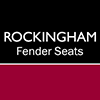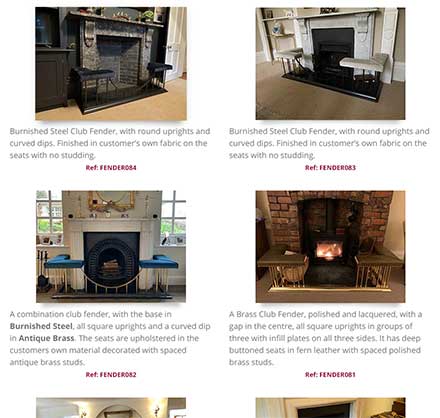If you want to understand a term that is commonly used to describe design features of a Fender Seat, Low Fender or Fire Surround then look no further! Just find the term in the list below and read the full explanation. If you need further help or think we should add anything to the list then please do get in touch.
Term |
Explanation |
| Antiqued | Applying a coating, typically to brass, to give it an aged effect. This leads to a darker patina which can be varied to suit each customer. |
| Base | The material that forms the bottom support for a Fender Seat, placed on the ground. The uprights (see below) attach into this to support the seat itself. Typically made in brass or steel, bases can also be made in a wood such as Oak or Mahogany, fitting in with the general design of the Fender Seat (or Low Fender). |
| Brushed Steel | Steel that has been carefully polished with the engineering equivalent of sandpaper. This gives it a very distinctive and contemporary silver appearance, with a less lustrous finish caused by the very fine lines in the material surface. |
| Brushed Brass | Brass that has been carefully polished with the engineering equivalent of sandpaper. This gives it a more modern look then standard or antiqued brass, with a less lustrous finish caused by the very fine lines in the material surface and is almost without shine. |
| Burnished Steel | Steel that has been carefully polished to give a very smooth surface. Burnishing removes irregularities in the metal surface leaving a very smooth and shiny surface which is the colour of slate. |
| Club Fender | A traditional name for a fender seat. |
| Collars | Optional adornments to the uprights on a Fender Seat that wrap around the upright where it enters the base or seat area. This adds detailing to the overall design. |
| Convex dip | See Curved Dip |
| Curved dip | Where a Gap (see below) is partly filled with a curved piece of material to add strength and add to the design of a fender seat, whilst still allowing access to the fire itself. A classic Fender Seat design feature. |
| Deep Buttoned | Where the material covering the seat on the Fender Seat itself has been fixed using buttons along its top surface. This leads to a tufted effect to the seat and can be used on leather as well as fabric seat materials. |
| Dulled Steel | See Brushed Steel |
| Formed Base | A base (see above) that has been made from pressing sheet steel to form a base with a radius. |
| Gap | A very common feature of Fender Seats – a break in the seating in the middle of the Fender Seat to allow access to the fire itself to add coal/logs. |
| Lacquered | A clear (generally) covering applied to steel or brass to provide protection. For steel this helps to avoid rust. For brass this helps to maintain the finish, whether polished, brushed or antiqued. |
| Leather | High quality leather provides a beautiful, natural finish that is very hard wearing. Available in a wide range of colours. |
| Polished Brass | Brass that has been polished with very fine substance to give a highly shined finish. |
| Return | The part of a Fender Seat or Low Fender that brings it away from the fireplace (i.e. the ‘sides’). Almost all Fender Seats feature returns of different sizes, although they can be omitted when the Fender Seat is to be fitted within a recess (ie. an Inglenook fireplace). |
| Roped | Where a piece of material has been formed to give a rope-like appearance. Typically used as a more decorative finish on Fender Seat uprights. |
| Satin Black | A black finish for steel achieved by applying chemicals and/or heat treatment which changes the colour of the steel surface. This surface is a black oxide and helps to protect the steel as well as giving a completely new look to the material. |
| Straight Dip | Where a Gap (see above) is left in its entirety with no material crossing it to allow access to the fire itself. Both an original and contemporary Fender Seat design feature. |
| Straight Across | A Fender Seat with no Gap (see above). Note: this can restrict access to the fireplace itself if it needs to be fed logs or coal, but gives more seating. |
| Twisted | Where a piece of material has been formed with a twist along its length. Typically used as a finish on Fender Seat uprights. |
| Upright | The vertical pieces of brass, metal or wood that support the seat. These can be made in various shapes: square, round, roped, reeded or twisted. |

